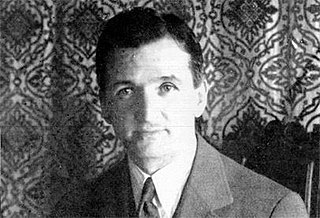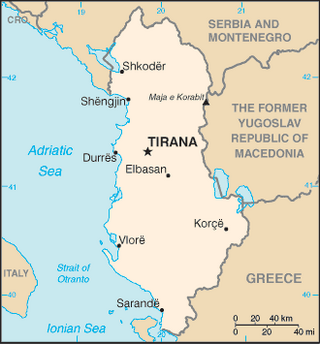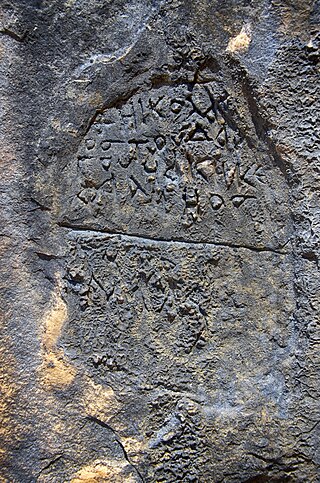
Butrint was an ancient Greek polis and later Roman city and the seat of an early Christian bishopric in Epirus.

Richard Hodges, is a British archaeologist and past president of the American University of Rome. A former professor and director of the Institute of World Archaeology at the University of East Anglia (1996–2007), Hodges is also the former Williams Director of the University of Pennsylvania Museum of Archaeology and Anthropology in Philadelphia. His published research primarily concerns trade and economics during the early part of the Middle Ages in Europe. His earlier works include Dark Age Economics (1982), Mohammed, Charlemagne and the Origins of Europe (1983) and Light in the Dark Ages: The Rise and Fall of San Vincenzo Al Volturno (1997).
Below are notable events in archaeology that occurred in 1928.

The Vivari Channel links Lake Butrint in the extreme south of Albania with the Straits of Corfu, and forms a border of the peninsula of Butrint.

Luigi Maria Ugolini (1895–1936) was an Italian archaeologist.

Phoenice or Phoenike was an ancient Greek city in Epirus and capital of the Chaonians. It is located high on an almost impregnable hill commanding the fertile valley below and near the modern town of the same name, Finiq, in southern Albania. It was the wealthiest city in Epirus and had the strongest walls until the Roman conquest. It was the location of the Treaty of Phoenice which ended the First Macedonian War. The city is part of an archaeological park.

Doclea or Dioclea, also known as Docleia or Diocleia, was an ancient Illyrian, Roman and Byzantine city, in the region of the Docleatae tribe, now an archeological site near Podgorica in modern Montenegro.

Neritan Ceka is an Albanian archaeologist, professor, and politician. He served as Albania's Minister of Internal Affairs from 27 July 1997 to 18 April 1998.

The Archaeological Museum of Apolonia is an archaeological museum approximately 8 km (5.0 mi) west of Fier, Albania. It was established in 1958. The museum contains artifacts unearthed nearby from the archaeological site of Apollonia and is close to the Ardenica Monastery.

The Illyrian Tombs of Selca e Poshtme are located near the town of Pogradec in Albania near the village of Selcë e Poshtme. On the right bank of the river Shkumbin at an elevation of 1040 m above sea level, lie the remains of the ancient city of Pelion and the accompanying necropolis. The Roman Via Egnatia led past it towards Thessaloniki. Though there are traces of human activity in Neolithic times, the settlement proper dates to the Iron Age through to the Illyrian urban period, and reached its height under settlement by the Illyrian tribe of Enchele in the later Iron Age and was also occupied in the Roman period as traces of a municipal building show. From the 4th to 1st centuries BC the city was the royal residence of Illyrian kings and therefore, also probably an important political and economic centre. In 1996, Albania included the Royal tombs of Selca e Poshtme in the UNESCO World heritage list of proposals.

The Cape of Rodon or Cape of Skanderbeg is a rocky cape on the Adriatic Sea north of Durrës, Albania. On the cape is the Rodoni Castle, built by Skanderbeg in 1463, and Saint Anthony Church. Further south in the bay between the cape and Rrushkull Reserve there exist several beach resorts like “Lura” and “San Pietro Resort”, gathering a considerable amount of tourists during the summer months.

This is a list of books in the English language which deal with Albania and its geography, history, inhabitants, culture, biota, etc.
Butrint Foundation is an international organization founded in 1993 in the UK by Lord Rothschild and Lord Sainsbury of Preston Candover. The foundation aims to conserve, preserve, and develop the Butrint site in southern Albania. Professor Richard Hodges has been director of archeology. The Packard Humanities Institute provides supports. Patrick Fairweather served as the foundation's first director, and was involved in the Buthrotum Roman archaeological site work from 1997 until 2004.
The Baptistery of Butrint, is an archeological site in Vlorë County, Albania and part of the Butrint National Park. Located in the archaeological site of Butrint, it is a late antique structure known for its well-preserved mosaic pavement. The centrally planned, circular baptistery is also notable as an ancient Roman monument adapted to the needs of Christianity.

The rock inscriptions of the Grama Bay Albanian: Mbishkrimet shkëmbore në Gjirin e Gramës) is an archaeological site in Southwestern Albania, Vlorë County, in the Grama Bay located on the Ionian coast of the Karaburun Mountains, including roughly 1,500 rock inscriptions that date from the 3rd century BC to the 15th-16th centuries. The name of the bay originates from the Greek word γράμμα meaning 'letter'.
Prehistoric Albania, compared to the other regions of the Mediterranean Europe, was relatively lately inhabited by Homo sapiens. The earliest known human settlement dates back to the Upper Paleolithic, 40,000 BC in the Kryegjata Valley, near the antique site of Apollonia. Several further Paleolithic sites have been excavated, out of which the most prominent ones are the cave of Konispol, the flint tools found near Xarrë, the shelters of the Blaz Cave near Urakë and the habitation of Mount Dajt, then during the period of the Mesolithic the aforementioned Kryegjata, Konispol and Gajtan sites represent more developed stone, flint and horn tools. Another important site of the Mesolithic industrial activity is the flint mine of Goranxi that was in operation around 7,000 BC.

The Venetian Fortress of Butrint is a castle on the Butrint Peninsula in southern Albania. The castle is located by the Channel of Vivari within the Butrint National Park and close to the neighbouring Venetian Triangular Castle.

The Cultural heritage of Albania is a blend of ancient traditions and historical influences that come together in Albania to create a rich mosaic of culture and history.

Archaeology of Albania represents a field of significant importance in uncovering the history and ancient culture of the Balkan region. Albania's geographical location has positioned it as a crossroads between the great civilizations of the Mediterranean and Southeastern Europe, making it rich in archaeological findings. Excavations and research have unveiled ancient civilizations, from the Bronze and Iron Ages to the Illyrian, Greek, Roman, and Byzantine periods.






















